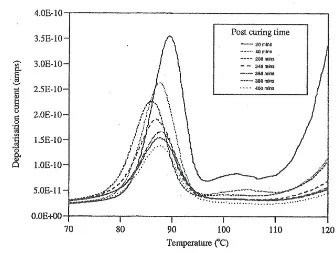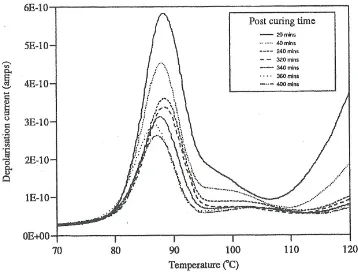Effect of Surface Treatments of Titanium Dioxide Pigments on
the Cure of Polyester/Trigylcidyl Isocyanurate Powder
Coatings
Stanley Affrossman, Anthony McKee and Richard A. Pethrick, WestCHEM, Department of Pure and Applied Chemistry
University of Strathclyde, Thomas Graham Building, 295 Cathedral Street, Glasgow G1 1Xl.
Abstract.
Titanium dioxide pigments will typically have an inorganic surface coating based on a blend of alumina and silica and an organic treatment. Both the organic and inorganic treatments can influence the cure characteristics of polyester powder coatings. This paper attempts to explore the connectivity between the nature of the coating and the cure behaviour of a typical heat cured epoxidised isocyanurate formulation.
It is found that a high silica: alumina content in the inorganic pacification layer significantly retards the cure process, but is influenced by the nature of the organic treatment. The organic surface treatment may accelerate or retard the initial cure process and gelation times. Elemental analysis indicates that certain of the pigments studied have a significantly higher zirconium content and exhibited enhanced cure rates compared with those with the lower zirconium content. This paper illustrates the potential effects of different grades of titanium dioxide on the cure of polyester powder coatings.
Keywords, polyester, trigylcidyl isocyanurate, cure data, thermally stimulated current measurements, dynamic mechanical thermal analysis.
Introduction
2 of the weight in terms of their surface alumina and silica pacification coating. The nature and quality of the protective coating is know to have an effect on the cure characteristics of certain resin systems [13,14]. The nature of the silica /alumina coating which is applied to the TiO2 pigment depends on the type of pigment being created [15,16]. TiO2
pigments can be created either via a sulphate or a chloride route [17].
In this paper, we explore the effects of changes in the protective surface coating and the organic treatment on the cure a typical powder coating based on a polyester/trigylcidyl isocyanurate formlation.
The sulphate route produces titanium dioxide after hydrolysis of the sulphate formed by treatment of the ore with sulphuric acid. The titanium dioxide has the anatase form which is converted to the rutile form by calcination. The calcination process involves passing the TiO2 through an oven which has an entry temperature of 3500C and an exit
temperature of 10000C and the process takes typically 12-16 hours. The rutile form is created by either prolonged heating at high temperature or by the addition of rutilising catalysts such as zinc or aluminium. Slow cooling is required to achieve a small particle sizes required to generate the desired opacity and scattering characteristics for an efficient pigment.
The chloride route involves the creation of TiCl4 by reaction of the ore with chlorine gas
which is in turn converted to the oxide by heating at 12000C. The TiO2 is formed in a fine
particulate state and has the rutile form.
For both pigments, pacification of the TiO2 particles involves application of a silica
/alumina coating. Various small organic molecules may also be added to aid the particle dispersion and enhance the performance of the pigments. The nature of the silica /alumina coatings on TiO2 has been investigated using a variety of surface analytical
techniques [15-20]. Examination of a range of Al2O3-SiO2 coated TiO2 pigments
produced [21]. The pigments used in this study cover the range of compositions typically found in conventional pigments but were especially prepared for the study..
Commercial polyester powder coatings are formulated from a blend of epoxy/polyester, polyester/triglycidyl isocyanurate [TGIC], and polyester /polyurethane [10-12]. In this paper the powder coating is a polyester based on terephthalic and trimellitic acid units combined with neopentyl glycol which is cured with triglycidylisocyanurate. On heating the protected triglycidylisocyanurate groups are activated and react with the available hydroxyl groups forming the polyester. The activation process can be acid/ base catalysed [22-25]. Modaflow, an ethyl acrylate-2-ethylhexyl acrylate copolymer is added to commercial resins to aid dispersion and flow and can influence the cure process.
The study aims to identify the influence of the silica/alumina ration in the pacification coating and possible effects of organic treatments on the cure process aiding the correct selection of the pigment type for a particular application
Experimental Materials
The polyester Uralac P 2400 obtained from DSM, Netherlands. The resin had an acid value of between 27-37 and a glass transition temperature of 630C. GPC analysis indicated the following values:- Mn – 6.32 x 102, Mw – 2.33 x 103, Mz– 5.01 x 103. the
Triglycidyl isocyanurate [TGIC] was supplied by Huntsman UK as was Araldite PT 810 which has an epoxy equivalent of 100-108 g/eq and a melting point of 91-95oC. The aid processing a low molecular weight polyacrylate copolymer of ethyl acetate and 2-hexyl acrylate was added in the form of Modaflow 2000 and has a Mn – 1.6 x 104, Mw – 3.3 x
104 and Mz – 4.9 x 104 and is used as a processing aid.
Titanium dioxide pigments
4 ethane [TME] and low molecular weight polyethylene wax [PE]. For each set of materials, a pigment is included as a baseline reference which does not have any organic surface treatment. The study includes pigments treated with both amine and polyol as these are know to be able to catalyse the epoxy ring opening cure process, but can also potentially interact with the Lewis acid and base sites in the silica and alumina surface coating. A low molecular weight hydrocarbon wax is included in certain types of coatings to aid dispersion in non polar media, such as polyethylene and is also included in this study..
Table (1) Pigment Analysis
Code Al2O3 SiO2 P2O5 ZnO K20 ZrO2 SO3 CaO Fe Sn Pb Cl Organic
[image:4.612.85.563.277.694.2]Concentrations in % with the exception of FE, Sn, Pb which are in ppm.
Surface area measurements
The surface area is important in defining the extent to which a pigment is capable of absorbing resin in the initial stages of cure and nitrogen adsorption isotherms were measured using a Micromertics Accusorb 2100E vacuum system for each pigment. Each sample was weighed accurately into a clean glass sample holder and then connected to the vacuum system. The sample was allowed to out-gas overnight at a temperature of 1800C under a pressure of 0,15 mm Hg. Once the sample had been fully out gassed it was cooled to 77K and its nitrogen adsorption isotherm was measured. For surface area measurements the nitrogen isotherm was measured for relative pressures between 0.05 and 0.35 whereas to determine porosity the complete isotherm was measured.
The BET surface areas of all the pigments used were measured and the typical accuracy was + 0.5 m2 g-1, table (2). t-Plots were also constructed for the pigments, using the procedure proposed by de Boer et. al. [26]. All pigments exhibited reversible Type II isotherms characteristic of non porous or macroporous surfaces. All the t-plots had the same shape at low relative pressures. The t-plots were linear and passed through the origin indicating unhindered multilayer adsorption is taking place on all parts of the surface. At high relative pressure the slope deceases which has been interpreted as being due to areas of surface being blocked for further adsorption. The adsorption data indicates that there is no capillary condensation occurring and that the pigments all have surface areas in the range 10-23 m2g-1. The differences arise primarily as a consequence of differences in the nature of the silica/alumina coating.
Table (2) Surface areas of pigments calculated using the BET equation.
Code Area (m2g-1) Code Area (m2g-1) Code Area (m2g-1) Code Area (m2g-1)
1A 13 1B 16 1C 15 1D 15
1E 15 2B 16 3B 17 4A 15
4B 20 4C 19 4D 18 4E 19
6
5E 18 6A 11 6B 12 6C 11
6D 12 6E 10
Powder coating production
The pigment was blended with 10% Modaflow in a water cooled Henshel mixer for ten minutes. The composition of the blends used are summarised in table (3). The pigment was compounded with the polyester in a twin screw extruder operating at 1000C and rapidly cooled on a water cooled bench. The extrudate was then granulated using a pin disc mill and classified so that the final powder passed through a 50 m sieve. This resin powder was then converted into pigment by the addition of TGIC and tioxide pigment. The formulations used were created on a 2kg batch scale and contained; 1029.8g polyester resin, 86.9g, TGIC, 138.5g, Modaflow, and 744.5 g pigment and for the unpigmented powder; 1637.4g polyester resin, 138.2g TGIC, 220.2g Modaflow. In both cases, the Modaflow is at a level of 1% with respect to the resin and the resin to TGIC ratio is 93:7. Formulations were also created to explore the effects of variations in the Modaflow to total resin ratio. In addition, certain other formulations were created in which the above ratios were changed, table (3). In all cases the pigment loading is 64.5% with respect to the resin. Many of the formulations were prepared in duplicate and certain in triplicate to check the consistency of the process. The pigments used for the nonstandard coatings were 4B and 6B. The powder coating was stored in air tight jars until required for analysis and testing.
Strathclyde curometer
the theory presented previously [26], the viscosity time profile was calculated. A viscosity of 104Pas was taken as indicating gelation of the material.
Table (3) Formulation of the powder coatings
Code (pigment) Pigment (g) Resin (g) Resin/Modaflow (g) TGIC (g) Pigment % Modaflow %
1 1357.9 37.4 104.8 0 0.25
2 (4b & 6b) 558.6 844.9 23.25 65.2 64.5 0.25
3 1320.9 74.7 104.5 0 0.5
4 (4b & 6b) 558.6 823.9 46.6 65.2 64.5 0.5
5 1102.9 294.1 103.0 0 2.0
6 (4b & 6b) 558.6 698.2 186.2 65.2 64.5 2.0
7 822.1 576.9 101.0 64.5 4.0
8 (4b & 6b) 558.6 530.7 372.4 65.2 64.5 4.0
9 (4b) 40.0 1604.8 219.5 135.7 2 1
10 (4b) 180.0 1490.2 203.8 126.0 11 1
11 (4b) 360.0 1342.8 183.7 113.6 24 1
12 (4b) 744.5 1029.8 138.5 86.0 64 1
13 (4b) 900.0 900.7 123.2 76.1 89 1
14 (4b) 1100.0 736.9 100.8 62.3 133 1
15(4b & 6b) 1369.9 27.9 0 102.7 2 0
16(4b & 6b) 1195.2 215.1 0 89.6 18 0
17(4b & 6b) 1038.1 384.1 0 77.9 37 0
18(4b & 6b) 923.1 507.7 0 69.2 55 0
19(4b & 6b) 1021.8 26.4 352.7 99.1 2 4
20(4b & 6b) 895.9 208.3 308.7 86.9 18 4
21(4b & 6b) 373.7 781.2 269.3 75.8 37 4
22(4b & 6b) 495.5 696.9 240.0 67.6 55 4
23 (6b) 90.7 1280.3 90.7 101.8 2 1
24 (6b) 79.3 1118.4 79.3 88.9 18 1
25 (6b) 68.7 972.5 68.7 77.3 37 1
26 (6b) 61.3 865.3 61.3 68.8 55 1
27 (6b) 20.0 1175.9 20.0 89.5 18 0.25
28 (6b) 40.0 1156.5 40.0 89.3 18 0.5
29 (6b) 156.7 1043.3 156.7 88.2 18 2
[image:7.612.86.527.150.720.2]8 Thermally Stimulated Discharge Measurements
The method has been described previously (29,30) and allows identification of the glass transition temperature, Tg and space charging effects which are important in the case of
powder coatings. Approximately 5g of powder was pressed into the form of a disc between smooth Teflon discs using a Spacec stainless steel die press of 3 cm diameter. An Apex hydraulic press Type 340-4 was used to apply a pressure of 3000 kgm-2 and was maintained at an appropriate temperature either to achieve consolidation or cure. Cure schedules was typically 28 minutes at 2000C. Poling of the sample was achieved by heating to the poling temperature Tp with a field of 5kVcm-1 applied for a period of 10
minutes. The sample was then cooled to 00C and the field removed by shorting the two electrodes. The discharge which is associated with the release of trapped charges was then measured using a Keighley 610C electrometer and the sample heated at a rate of 30C min-1 under a nitrogen atmosphere. Traces were obtained over the temperature range from 298 - 473K.
Dynamic Mechanical Thermal Analysis
A Rheometrics Dynamic Mechanical Thermal Analyser (DMTA) was used in three point bending mode and operated over a temperature range -180 to +3000C and frequency range 0.01 to 200 Hz. The samples studied were ~1 mm thick and produced by curing an appropriate amount of powder in a PTFE coated mould. Measurements were made at a frequency of 1Hz. The output data were the bending modulus E’ and tan δ.
Results and Discussion Curometer Measurements
A typical curometer traces for the polyester/TGIC powder coating is shown in figure (1). The initial amplitude of the probe motion is large, the probe moving freely through the free flowing powder, figure (1A).
[A]
[B]
[image:9.612.168.428.146.632.2]10 As the powder melts its wets the probe and initially forms a viscous liquid layer. Further heating of the melt, lowers the viscosity and the amplitude of the motion of the probe increases. The initial drop in amplitude is a reflection of the melting and wetting process for the probe. Once the powder has melted activation of the TGIC can start to occur and cure of the resin is initiated. The start of the cure process can be designated by the point A, which corresponds to the formation of the molten resin mixture. The initial change in amplitude reflects the change in the viscosity. The initial decrease in the amplitude is proportional to the increase in the increase in the viscosity. As the cure proceeds then viscosity becomes complex and the quadurature signal rises as the fluid takes on viscoelastic characteristics. The temperature of the powder is rising as indicated in figure (1B) and the cure temperature is reached after about 500 seconds. At this time the powder has become fairly fluid and the amplitude of the motion of the probe has risen to almost the value which it had when immersed in the original powder and the quadurature has dropped indicating the fluid is less viscous. As cure proceeds the amplitude falls and eventually when cure is completed the amplitude becomes constant and reflect the fact that the coating is now in a rubbery state.
The gelation of the coating is reflected in the quadurature having a maximum value, designated point B, whereas vitrification corresponds to the point at which the amplitude has reached a small but constant value. The accuracy of the method for the characterisation of the cure times was checked by performing six measurements on the unpigmented coatings. The average gelation time was found to be 828 + 15 seconds. The time between point A and point B was designated the ‘initial cure time’ and values of 434 + 17 seconds were observed. The main sources of errors in the measurement were attributed to variability of the thermal contact between the sample and the metal heating block and differences in the depth to which the probe was immersed in the powder coating.
Effects of organic surface treatment of the pigment on the cure behaviour.
[TME] and low molecular weight polyethylene wax [PE]. These compounds have both the ability to interact with acid and basic sites or be adsorbed on the pigment surface and influence the TGIC reaction. The organics are added to the slurry after the deposition of the silica:alumina coating and the excess is removed in the drying process. Low levels of these molecules will be adsorbed on the surface of the coating depending on the nature of the sites present.
The ST(x) coded pigments were prepared with and without the addition of any organic treatment but with varying silica:alumina ratios in the coatings. The cure characteristics are presented in Table (4), the initial cure time is designated by A in figure (1) and corresponds to the point at which the viscosity starts to increase whereas point B is designated as the gelation time. In certain of the formulations, the cure was inhibited and this point could not be precisely determined. Comparison of the cure times for the pigment which had not been treated with an organic coating, table (4) are 1A (Si - 0.11) (390s), 4A (Si - 1.32) (360s), 5A (Si -4.00) (460s) and 6A (Si - 2.03) (600s) shows an initial drop to 600s at 2.03% and then a decrease with increasing SiO2 content in the
coating. The gelation times for 1A (1010s), 4A (1300s) and 5A (1760s) show a progressive increase as the silica:alumina ratio is increased. The pigment 6A which contains equal amounts of silica and alumina did not show a clear gelation time.
[image:11.612.85.533.485.701.2]
Table 4 Gelation times for various formulations. Code
(pigment)
Initial cure time (secs)
Gelation time (secs)
Code Initial cure time (secs)
Gelation time (secs)
ST1(neat) 390 820 ST2 (1A) 430 1010
ST3 (1B) 370 1080 ST4 (1C) 380 1070
ST5 (1D) 340 910 ST6 (1E) 370 890
ST7 (2B) 260 710 ST8 (3B) 360 1130
ST9 (4A) 360 1300 ST10 (4B) 390 1160
ST11 (4C) 360 1070 ST12 (4D) 340 1010
ST13 (4E) 270 720 ST14 (5A) 460 1760
12
ST17 (5D) 400 1290 ST18 (5E) 330 790
ST19 (6A) 600 - ST20 (6B) 560 2020
ST21 (6C) 570 1840 ST22 (6D) 550 -
ST23 (6E) 390 1050
Changing the silica:alumina ratio, which will alter the acid-base nature of surface of the pigment, and appears to inhibit the cure process, implying that the pigment surface is interacting with the curing resin system.
Trimethyol propane [TMP]
Comparison of the initial cure time data for 1B (Al20:Si02; 3.53:0.11) (370s), 2B
(Al20:Si02; 3.53:0.11) (260s), shows a decrease in the initial cure time for essentially the
same level of alumina and silica in the coating and the only difference between the pigments is the zirconium level in the pigment. Zirconium may be present as either the oxide Zr02 or as the sulphate and its presence appears to accelerate the cure, . Increasing
the silica level 5B(Al20:Si02; 0.61:4.00) (470s) increases the initial cure time indicating a
less efficient initiation process and it was difficult to determine the gelation time. Pigment 6B (Al20:Si02; 2.39:1.96) (560s) has a lower level Zr(0.024) and a higher level
of SiO2 and shows the expected retardation of the initial cure with increase in silica level.
The gelation times for the pigments; 1B (1080s), 2B (710s) follow the trend in the initial cure times and indicate that the zirconium appears to be catalysing the cure whereas 4B (1160s) and 6B (2020s) show that increasing the SiO2 is retarding the cure. This
observation implies that the zirconium may be segregating to the surface to some extent, however we were not able to prove this.
An alternative explanation for the fast cure in the case of 2B could be the effects of the TMP, however since this is present in all the B series pigments it is difficult to explain why it should only have an effect in pigment B, which is curing faster than the neat resin.
Triethylamine [TEA]
data for 1E (Al20:Si02; 3.38:0.11) (370s), with 4E (Al20:Si02; 4.29:0.09) (270s) shows a
dreaces in the initial cure time with increased alumina content, however 5E (Al20:Si02;
0.67 : 4.05) (330s) and 6E (Al20:Si02: 2.37:1.93) (390s) shows a more complex change
with silica content and pigments 4A (Al20:Si02: 4.24:1.32) (360s) and 5E (Al20:Si02:
0.61:4.05) (330s) are showing cure behaviour which is faster than that of the pure resin. This implies that the TEA may be having a catalytic effect on the initial stages of TGIC activation. The gelation times: 1E( 890s), 4E (720s), 5E (790s) and 6E (1050s) show cure times which are faster than those of the pure resin for low silica levels but become slower for the higher silica levels, when the zirconium level is low. The data once more indicate that the zirconium is influencing the cure process, presumably by changing the surface chemistry but we must also consider the catalytic effect of the TEA on the epoxy cure process.
Trimethyol propane [TMP] / polyethylene wax.
The addition the PE wax will not be expected to catalyses the reaction, but could block some of the active surface sites on the pigment. Comparison of the initial cure data for 1C (380s) 1D (380s), 4B (390s), and 4C (360s) indicates the addition of the wax has eliminated the effect of the surface seen with TMP alone and this trend is reflected in the gelation times; 1C (1070s), 1D (910s), 4B (1160s) and 4C (1070s) which are similar with the exception of 1D which is slightly faster.
Modaflow effects on cure
In commercial formulations, small amounts of flow control agents, such as Modaflow are added to avoid problems such as ‘orange peel and pin hole formation. The Modaflow which is an ethyl acrylate-2-ethylhexyl acrylate copolymer has the potential of interacting with the pigment surface and blocking certain surface sites. The effect of varying levels of Modaflow addition between 0 and 4% on the cure process, for unpigmented and two pigmented resins, 4B and 6B were investigated, figure (2).
The dominant effect is the nature of the pigment; 4B (Al2O:SiO2; 4.40 0.1) showing
comparable rates of cure to the unpigmented resin, whereas 6B (Al2O:SiO2; 2.39:1.96) is
14 Addition of a low level of Modaflow to the resin reduces the initial cure time but further addition increases the initial cure time, figure (2). High levels ~4% of Modaflow produce a reduction in the initial cure time and there is no evidence of blocking of surface sites as seen in the case of the wax addition. Both pigments were treated with TMP and the changes in the cure characteristics appear attributable to changes in the SiO2 level from
0.12% in 4A to 1.96 in 6B. The addition of between 0.5 and 1% of Modaflow causes an increase in the gel times for the 4B pigment which has the highest level of SiO2, whereas
4B, which is the pigment with the highest level of Al2O3 shows an initial cure time which
is faster than the pure resin.
[B]
Figure (2) Initial Cure Time [A] and Gelation Time [B] as a function of Modaflow level. Key:- ■ – unpigmented, - pigment 4B at 64% loading, ▲ - pigmented 6B at 64% loading. Error bars are the size of the data points
Effect of pigment loading in a Modaflow free coating
[image:15.612.184.433.73.300.2]16 [A]
[B]
Figure (3) Effect of Pigment loading of Modoflow free coatings. Key:- ■ – unpigmented, - pigment 4B, ▲ - pigmented 6B. Error bars are the size of the data points
[image:16.612.169.443.71.577.2]
A series of experiments were performed on coatings prepared with 1% of Modaflow in the coating, figure (4). Whereas in the unpigmented coatings the cure process appears to be unaffected by low levels of pigment addition, when Modaflow is present there is a significant reduction in the initial cure time for 4B whereas 6B exhibits behaviour which is similar to the coating which does not contain Modaflow. The reduction in the initial cure time with 4B may be attributed to the effect of Modaflow assisting the viscosity reduction and promoting the activation process. As with coatings which did not contain Modaflow, pigment 6B shows a more significant effect on both the initial stages of cure and on gelation times than 4B. The difference in observed behaviour reflects the changes in the silica: alumina ratio in the pigments surface coating.
18 [B]
Figure (4) Effect of pigment loading on Initial Cure Time[A] and Gelation Time [B] with 1% Modaflow. Key:- - pigment 4B, ▲ - pigment 6B. Error bars are the size of the data points
Effect of pigment loading with 4% Modaflow being present
Coatings containing 4B and 6B with a 4% Modaflow level were studied, figure (5).
[image:18.612.181.433.75.296.2][B]
Figure (5) Effect of pigment loading on Initial Cure Time[A] and Gelation Time [B] with 4% Modaflow. Key:- - pigment 4B, ▲ - pigment 6B. Error bars are the size of the data points
The initial cure time is inhibited relative to the unpigmented material but at 4% Modaflow loading the relative differences between the 4b and 6B pigments are reduced, the 6B still being inhibited more than the 4B. At 4% Modaflow loading the differences between the two pigments is significantly reduced and it is only at the highest loading ~ 60% that differences between 4B and 6B become evident.
The Modaflow appears to act in a similar manner to the wax and block the effect of specific surface sites on the cure process. The increase in the initial cure and gelation time reflect the inhibition effect of the pigment on the cure process. As the pigment level increases so the amount of resin to be cured decreases which should lead to faster cure times than for the pure resin. However increasing the filler level increases the thermal mass and reduces the cure exotherm leading to a slower cure process. The general upward trend in the initial cure and gelation times is therefore partly attributed to the increase in thermal mass effects on the cure process.
[image:19.612.182.429.74.291.2]
20 Modaflow has a small effect on the cure reaction of the polyester, assisting the initial melt and lowering the viscosity of the resin but this does not necessarily lead to a significant effect on the gelation times. The optimum Modaflow concentration appears to be ~ 1.5%. The dominant effect in terms of change in the initial cure and gelation times is change in the silica content of the pigment coating. A high silica content appears to retard the polymerization reaction. The observed retardation effects must be due to direct chemical interaction between the pigment and the components of the polyester curing system. Two main mechanisms for the retardation can be proposed:-
i) The surface rich in silica has the potential of adsorbing the reactive polyester end group and inhibiting the reaction by reducing the number available for reaction. Whilst this possibility can not be excluded the low surface area of the pigments c.a. 10m2 g-1 would suggest that the effect should be quite small and is not totally consistent with the observations of inhibition observed.
B + RCOOH BH + RCOO RCOO + CH2 CH R
O
O
2 CH R
CH RCOO
RCOO CH2 CH R O
+
RCOO CH2 CH R O
+ BH
RCOOH
RCOO CH2 CH R OH
+ B
O
2 CH R
CH RCOO
H
+ RCOO
Scheme (1)
The Modaflow appear to be adsorbed, in part onto the pigment surface sites and hence effectively blocks their ability to interact with the catalyst. Pigment 4B has a low silica level and has the least effect on cure, whereas 6B has a higher silica level and shows significant retardation effects on the cure process. The curometer data shows that the surface coating on the titanium dioxide surface has a significant effect on the cure of polyester coatings and the nature of effects can be influenced by the presence of zirconium in the pigment.
Thermal Stimulated Discharge Spectroscopy -TSD
The TSD method allows determination of the dynamic and electrical response of coatings (30, 34). A typical set of TSD traces for a cured polyester coating made at various stages of cure at 1200C, are shown in figure (6). This coating does not contain pigment and post curing of the film causes the location of the peak to move, initially, to lower temperatures and then finally to higher temperatures. The peak is associated with the onset of motion in the matrix which assists discharge of trapped charges and is associated with the glass to rubber transition [Tg]. The shifts observed are consistent with the initial network
formation creating an open structure which on densification leads to the observed increase in Tg. The start of a peak above 1100C is associated with space charge effects in
22 Figure (6) Effect of Post cure on the thermally Stimulated Depolarization traces for an unpigmented polyester coating
As cure proceeds, the space charge contribution decreases which reflects the formation of the crosslinked network inhibiting charge migration through the film. Usually post cure leads to an increase in the Tg, however in the case of the polyester this is not the case, the
final Tg being lower than the value at 300 minutes. The down ward shift of the Tg peak on
post cure is rather unusual, and implies that the glass transition temperature of the coating decreases on post cure and reflects relaxation of initially stresses formed in the matrix on post cure. The relaxation of the stresses in the matrix will be assisted by the presence of Modaflow and the final value of Tg is 87oC.
[image:22.612.137.473.74.327.2]Figure (7) Effect of Post cure on the thermally Stimulated Depolarization traces for polyester coating with pigment 4B and Modaflow.
The shifts during the cure and post cure processes are much smaller implying that interaction of the resin with the pigment reduces the extent to which morphological changes are occurring in the resin phase. The final value of the Tg is similar to that in the
pure resin. Post cure reduces the amplitude of the space charge peak consistent with a reduction in mobility of the charges in the system. The final value of Tg has a value of
880C. Parallel measurements without Modaflow being present gave values of 1080C indicating that it is aiding the structural changes within the curing matrix.
Cure of pigmented polyester with 6B and Modaflow, figure (8), shows a progressive downwards shift of the Tg as the cure proceeds, however the final value of the Tg is
[image:23.612.103.461.80.354.2]24 Figure (8) Effect of Post cure on the thermally Stimulated Depolarization traces for polyester coating with pigment 6B and Modaflow.
Dynamic Mechanical Thermal Analysis
DMTA measurements were performed on the coatings and a typical trace is shown in figure (9). The traces obtained for all the coatings were very similar and confirmed the location of the Tg process as being at ~ 900C. Small differences were observed with
change in the pigment and the level of Modaflow, the latter shifting the Tg to lower
temperatures.
[image:24.612.150.463.77.310.2]Figure (9) Dynamic Mechanical Thermal Analysis trace for a cured polyester coating. Key:- top trace is the bending modulus and the lower trace tan .
Conclusions
The study indicates that the nature of the surface pacifying for titanium dioxide pigments is important when they are used with polyester curing systems. Studies using polyacrylic acid have shown that TiO2 adsorbs polymer on to its surface [36]. It is therefore
reasonable to expect that the polyester will be able to be adsorbed by pigment and in the solid phase can play an important role in determining the distribution of pigment in the system [10, 37-38]. The effects of the surface coatings on the pigments behaviour dependent on the silica level in the coating and imply that there is an interaction between the surface and catalyst which inhibits its effectiveness in catalysing the cure reaction. The presence of zirconium appears also to have an effect on the cure behaviour possible through its influence on the nature of the surface layer created during the coating process.
Acknowledgements
[image:25.612.166.440.76.297.2]26 References
1) Edgerton T.A.; Parfitt, G.D.; Kang, Y; Wightman, J.P.; XPS Analysis of Uncoated and Silica-Coated Titanium-Dioxide Powders, Colloids and Surfaces (1983) 7 (4) 311-323.
2) Egerton T.A.; King, C.J.; Influence of Light-Intensity on Photoactivity in TiO2 Pigmented Systems, Journal Oil & Colour Chemists Association (1979) 62 (10) 386-391. 3) Montazer M., Moeshedi S., Nano photo scouring and nano photo bleaching of raw cellulosic fabric using nano TiO2 International Journal of Biological Macromolecules 50 (2012) 1018-1025.
4) Su X., Wu Q. L., Zhan X., Wu J., Wei S., Guo Z., Advanced titania nanostructures and composites for lithium ion battery, J Mater Sci (2012) 47:2519–2534
5) Al-Ahmed A., Mukhtar B., Hossain S., Zaidi S.M.J., Rahman S.U., Application of Titanium dioxide (TiO2) based photocatalytic nanomaterials in Solar and Hydrogen Energy: A Short Review Materials Science Forum Vol. 712 (2012) pp 25-47
6) Macwan D.P., N. Dave P.N., Chaturvedi S., A review on nano-TiO2 sol–gel type syntheses and its applications, J Mater Sci (2011) 46:3669–3686
7) Lang X., ,Chen X., Zhao J., Heterogeneous visible light photocatalysis for selective organic transformations: Chem. Rev. 2014 43 473 -485
8) Froschl, T., Hormann, U., Kubiak, P., Kucerova G., Pfanzelt, M., Weiss C.K., Behm R.J., Husing,N., Kaiser U., Landfesterd K., Wohlfahrt-Mehrens M., High surface area crystalline titanium dioxide: potential and limits in electrochemical energy storage and catalysis Chem. Soc. Rev., 2012,41, 5313–5360
9) Croll S., DLVO theory applied to TiO2 pigments and other materials in latex paints Progress in Organic Coatings 44 (2002) 131–146
10) Farrokhpay S. A review of polymeric dispersant stabilisation of titania pigment, Advances in Colloid and Interface Science 151 (2009) 24–32
11) Croll S.G., Taylor C.A., Hydrated alumina surface treatment on a titanium dioxide pigment: Changes at acidic and basic pH. Journal of Colloid and Interface Science 314 (2007) 531–539
13) Juergen H. Braun J.H., Baidins A., Marganski R.E., TiO2 pigment technology: a
review, Progress in Organic Coatings, 20 (1992) 105-138
14) Entwistle T; Gill S.J., Effect of Titanium –Dioxide Pigments on the Cure of Thermosetting Films, Journal Oil & Colour Chemists Association (1986) 69 (2) 25-42. 15) Rusu, M.; Mindrila, P.C., The optimization of some white epoxy-polyester coating powders composition Materiale Plastice (2004) 41 (1) 29-35.
16) Johansson, L.S.; Losoi, T., Surface Characterization of Coated Powders - Al2O3-SiO2-Coated TiO2, Surface and Interface Analysis, (1991) 17 (5) 230-236.
17) Hanna, T. R., Predicting Paint Properties from TiO(2) Pigment Properties, J.C.T. Coatings Tech (2009) 6 (5) 26-31.
18) Wiseman T.J., Characterisation of Powder Surfaces, Chapter 4, Ed Parfitt G.D. and Sing K.S.W., Academic Press, New York (1976).
19) Johansson L.S., Static SIMS Studies of Coated TiO2 Pigments, Surface and Interface Analysis (1993) 20 (4) 304-308
20) Morterra C., Cerrato G., Visca M., Lenti D. M., Surface Characterization of some Ti0,-based Pigments, Part 3. - Coating of the Pigment, J. Mater. Chem.1992, 2(3), 341-355
21) Mirabedinia,S.M. Kiamanesh A., The effect of micro and nano-sized particles on mechanical and adhesion properties of a clear polyester powder coating Progress in Organic Coatings 76 (2013) 1625–1632.
22) Vargha1 V., Vorster O., Finta Zs., Csuka G., TTT Analysis of a Powder Coating System based on Polyester Resin and Triglycidyl-Isocyanurate Part I. Gelation of Matrix and Powder, Journal of Thermal Analysis and Calorimetry, Vol. 83 (2006) 1, 199–206 23) Swaraj P., Surface Coatings; Science and Technology, Wiley Interscience, New York, Journal of Thermal Analysis and Calorimetry, Vol. 83 (2006) 1, 199–206
24) Kapilow L., Sammel R., Resins and Curing Agents for Thermosetting Powder Coatings, J. Coating Technology (1987) 59 (750) 39-4759
28 26) de Boer J.H.; Lippens B.C.; Linsen, B.G.; Broekhof J.C.; Vandenhe A.; Osinga T.J.; T-Curve of Multimolecular N2-Adsorption, J. Colloid and Interface Science (166) 21 (4) 405-410.
27) Affrosman S., Collins A., Hayward D., Trottier E., Pethrick R.A., Versatile Method of Characterizing Cure in Filled Reactive Polymer Systems, J. Oil & Colour Chemists Association, (1989) 72 (11) 452-453.
28) Ingram S., Dennis H., Hunter I., Liggat J.J., McAdam C., Pethrick R.A., Schaschke C., Thomson D., Influence of clay type on exfoliation, cure and physical properties of in situ polymerised poly(methyl methacrylate) nanocomposites Polym Int (2008) 57 1118– 1127
29) Van Turnhout J. in ‘Electrets’ – Topics in Applied Physics “ Ed G.M.Sessler, Vol 33 (1980) Springler Verlag , Berlin.
30) R.A. Daly J.H., Hayward D., Pethrick R.A., Studies of Dielectric-Constant
Measurements and Tribo-Electric Charging of Pigmented Polymer Systems, J. Physics D – Applied Physics ( 1986) 19 (5) 885-896.
31) May C.A. ‘Epoxy Resins: Chemistry and Technology’, 2nd Edition Marcel Dekker, New York (1980)
32) St Pierre L.E., Polyesters Part (1) Polyalkylene oxides and other Polyesters’ Chapter 3 Ed Gaylord N.G. Interscience (1963)
33) Smith R.E., Larsen F.N. Long CV.L., Epoxy resin cure. I. Fluorine-19 NMR of boron trifluoride monoethylamine and fluoroboric acid, J.Applied Polymer Science 29 (1984) 3697- 3711.
34) Shi Q-W., Huang W., Zhang Y., Zhang Y., Xu Y., Guo G., Curing of polyester powder coating modified with rutile nano-sized titanium dioxide studied by DSC and real-time FT-IR., J Therm Anal Calorim (2012) 108 1243–1249
35) Creswell R.A., Perlamn M.M., Thermal Currents from Corona Charged Mylar J. Applied Phys (1970) 41 2365-2375
36) Banash M.A, Croll S.G., A Quantitative study of polymeric dispersant adsorption onto oxide-coated titania pigmentsProgress in Organic Coatings 35 (1999) 37–44
37) Farrokhpay S., Morris G.A., Fornasiero D., Self P., Stabilisation of titania pigment
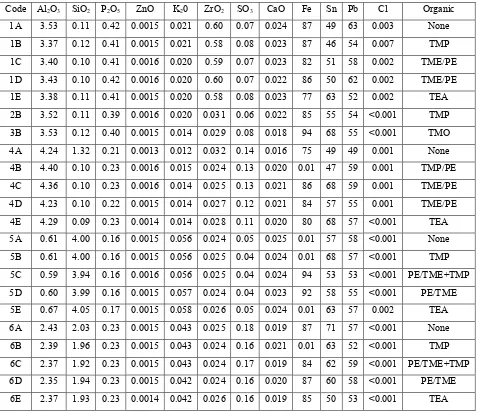
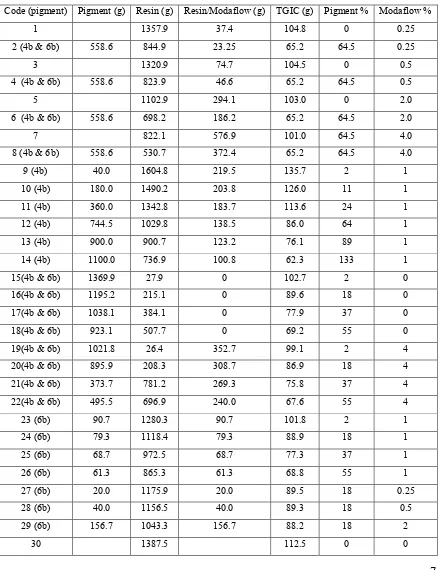
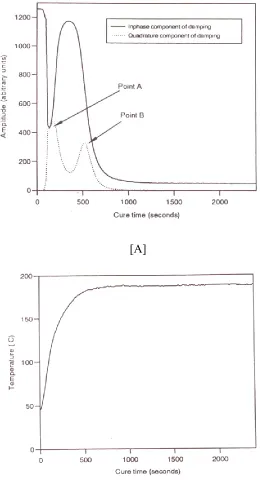
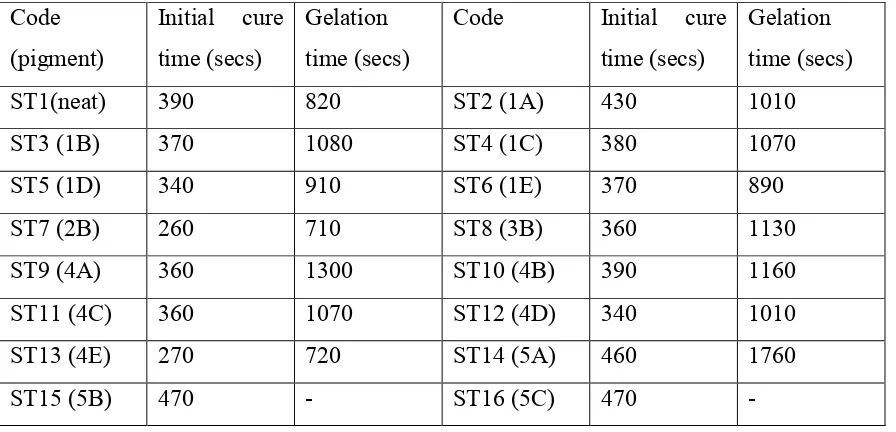
![Figure (2) Initial Cure Time [A] and Gelation Time [B] as a function of Modaflow level](https://thumb-us.123doks.com/thumbv2/123dok_us/1574020.109994/15.612.184.433.73.300/figure-initial-cure-time-gelation-time-function-modaflow.webp)
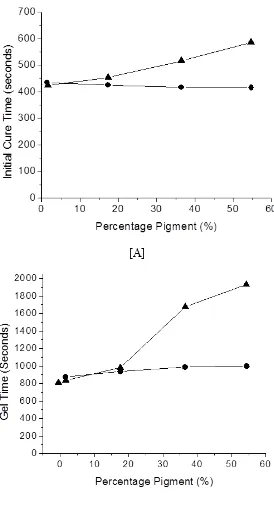
![Figure (4) Effect of pigment loading on Initial Cure Time[A] and Gelation Time [B] with](https://thumb-us.123doks.com/thumbv2/123dok_us/1574020.109994/18.612.181.433.75.296/figure-effect-pigment-loading-initial-cure-time-gelation.webp)
![Figure (5) Effect of pigment loading on Initial Cure Time[A] and Gelation Time [B] with](https://thumb-us.123doks.com/thumbv2/123dok_us/1574020.109994/19.612.182.429.74.291/figure-effect-pigment-loading-initial-cure-time-gelation.webp)
